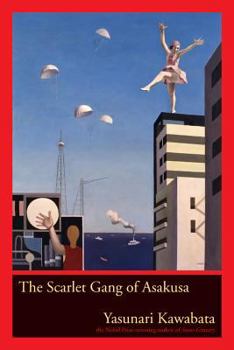The Scarlet Gang of Asakusa
Select Format
Select Condition 
Book Overview
In the 1920s, Asakusa was to Tokyo what Montmartre had been to 1890s Paris and Times Square was to be to 1940s New York. Available in English for the first time, The Scarlet Gang of Asakusa, by Nobel Prize winner Yasunari Kawabata, captures the decadent allure of this entertainment district, where beggars and teenage prostitutes mixed with revue dancers and famous authors. Originally serialized in a Tokyo daily newspaper in 1929 and 1930, this vibrant...
Format:Paperback
Language:English
ISBN:0520241827
ISBN13:9780520241824
Release Date:April 2005
Publisher:University of California Press
Length:279 Pages
Weight:0.70 lbs.
Dimensions:0.7" x 5.6" x 8.3"
Customer Reviews
2 ratings
Scarlet, Black and Blue
Published by Thriftbooks.com User , 18 years ago
The bruised characters of the underbelly of Asakusa Tokyo life are introduced to us in this early book by the brilliant author Yasunari Kawabata. This first English translation of the master's work contains some "extras"- ncluding Donald Richie's memories of a first meeting with the author. This was my first introduction to Kawabata, and was a wonderful read. It made me want to know more about the time and that world, and to read more Kawabata-an author I have learned to deeply respect and admire and cherish.
Fascinating early effort by Kawabata; not really about gangs.
Published by Thriftbooks.com User , 19 years ago
The Scarlet Gang of Asakusa was one of Kawabata's earlier works, written after he had already achieved some recognition in Japan with The Izu Dancer, but well before his worldwide breakthrough Snow Country. The novel (now translated into English for the first time ever) takes place in a thriving entertainment district in Tokyo, at a time when Japan was rapidly industrializing, building universities, importing Western technology and making its own, in order to establish itself as a world power. Kawabata's choice of setting was especially well-suited for capturing the spirit of these times, because a place like Asakusa was a perfect illustration of the way the Japanese culture itself was changing: jazz music and flapper dresses became popular, music-halls and vaudeville theatres edged out traditional forms of entertainment, and gender roles were suddenly much less rigid, ambiguity was fashionable, images of ennui-ridden "modern boys" and provocative, alluringly dangerous "modern girls" became so iconic that the words designating them ("mobo" and "moga") entered everyday vernacular. This novel can be read as a valuable document of this interesting and short-lived period in Japanese history. Nominally, the story revolves around The Scarlet Gang, one of many youth gangs running around Asakusa at the time. Their exploits are related by a nameless, first-person narrator, whose association with members of the gang gives him an excuse to wander around Asakusa and observe various aspects of life there, in a detached and casual manner. Often, the things he sees are unrelated to each other, and he flits from place to place without lingering anywhere for too long, which makes his account seem more like a set of anecdotes about Asakusa life than like a coherent narrative. In fact, the role in the plot of The Scarlet Gang itself is secondary to these anecdotes. The narrator hints that the gang is involved with criminal activities, but never really explains what those activities are, or how the gang profits from them, or even what people are actually in the gang. Only a few members of the gang are encountered in the book, and when they do appear, they're not doing anything gang-related. It seems that the gang's sole purpose is to give a certain outlaw mystique to its members. Although the ostensible goal of the book may be to create a general portrait of Asakusa life, Kawabata is drawn to deeply introspective, intensely personal stories, as he was in every work he ever wrote. So, when a few distinct plot threads begin to emerge from the book's seemingly formless narrative, they all deal with very specific, individual passions and emotions. The longest of these coalesces around Yumiko, Asakusa slum dweller and prominent member of The Scarlet Gang; her sister, we learn, was seduced and abandoned by a certain man, and eventually Yumiko meets this man, entices him, and takes revenge. Yumiko is a strange character. She knows the score, talks cynically about prosti






